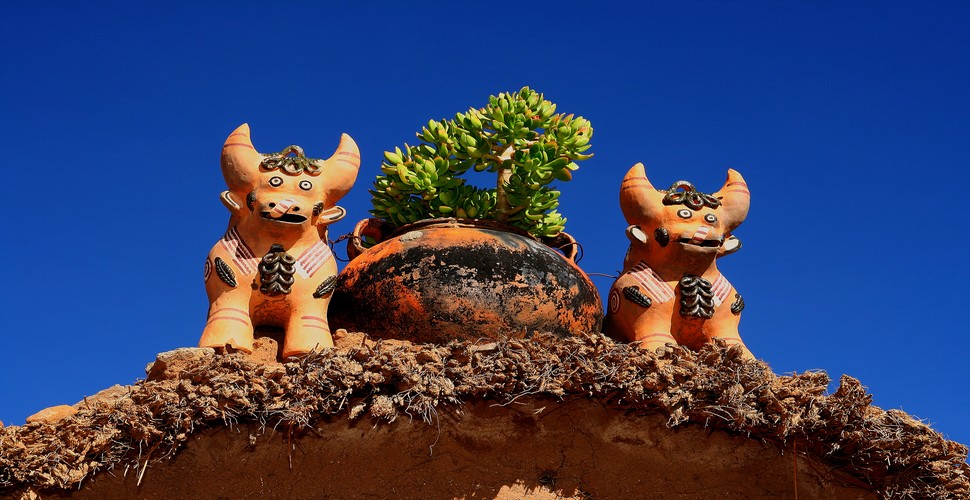

Claire Dean
Travel in South America is a joy to behold. The rich variety of destinations, experiences, landscapes and geography fascinated me so much, that I chose to relocate here, over 20 years ago! The best thing I ever did! Allow me to share my knowledge and passion for Central and South America with you and help you plan your holiday of a lifetime!

The Andean Tradition of Toritos Peruanos
Written by:Claire Dean
Last Update: 2025-01-22
In the picturesque Andean region of Pucara, nestled within the Andean highlands of Peru's Puno region, a unique and fascinating tradition thrives to this day. Two colorful Toritos Peruanos (2 small bulls) stand guard on the roofs of houses, carrying with them the rich heritage of Andean folklore. These small yet potent sculptures are believed to be guardians of good luck and symbols of protection for the households they watch over. In this article, we will delve into the origins and significance of the Andean tradition of the Toritos Peruanos in the Pucara region of Puno.
Pucara Church
The Origin of the Tradition
The tradition of placing Toritos on the rooftops can be traced back to pre-Hispanic times when the Andean people of Pucara deeply revered and worshipped animals. The Torito, or little bull, held particular significance as a representation of strength, fertility, and protection against malevolent forces. In ancient Andean cosmology, it was believed that these bull-like figures could ward off evil spirits and bring prosperity and harmony to the community. These small bulls are an important part of Peruvian culture and are often associated with good luck, protection, and other positive attributes. Here are a few other regions in Peru where you might come across these traditional Toritos.
Pucara Bulls on Sale
- Cajamarca - In the northern highlands of Peru, particularly in the region of Cajamarca, Toritos are commonly used as decorative elements during festivals and celebrations. They are often made from colorful materials like straw, adorned with ribbons, and displayed in public spaces as part of religious and cultural festivities.
- Ayacucho - The city of Ayacucho, located in the central highlands of Peru, also has a strong tradition of using Toritos in its local festivals. These bull figurines are usually made of ceramic or wood and play a central role in traditional dances and parades during events like the Inti Raymi festival.
- Cusco - In the historical Inca city of Cusco, located in the southeastern Andean region of Peru, Toritos are an integral part of the city's cultural heritage. They are often used in religious processions and dances, especially during the annual Inti Raymi celebration, which honors the Incan sun god Inti.
- Lima and Other Urban Areas - While the tradition of the Toritos is deeply rooted in rural and traditional communities, you can also find them in urban areas like Lima, especially in handicraft markets and shops catering to tourists and those interested in Peruvian folklore.
It's important to note that the specific designs and uses of Toritos can vary significantly from region to region, and each community may imbue these small bulls with their own unique meanings and symbolism. They remain a cherished aspect of Peruvian culture, reflecting the country's rich heritage and diverse traditions.
Ornate Pucara Bulls
The Symbolism of the Toritos Peruanos
Guardians of Good Luck
The Toritos Peruanos are seen as bringers of good fortune and prosperity. By placing them on rooftops, the Andean people believe that they will protect the household from misfortune and attract positive energies.
Toritos on a Roof, Pucara
Connection to Ancestral Spirits
The tradition of the Toritos reflects the Andean people's deep spiritual connection with their ancestors and the natural world. It is believed that the spirits of their forefathers inhabit these colorful figurines, acting as intermediaries between the living and the spiritual realms.
Painted Torito
Cultural Identity
The Toritos Peruanos are an integral part of the Andean culture, representing the continuity of ancient traditions and values in the face of modernity. They are a source of pride and identity for the people of Pucara.
Pucara Rooftops
Prosperity and Fertility
The bull has long been associated with agricultural fertility, and the Toritos' presence is believed to bless the land with abundance and successful harvests.
Red Torito
The Colors and Their Meanings
The Toritos Peruanos are adorned with vibrant colors, each carrying specific meanings deeply ingrained in Andean symbolism
- Red - Symbolizing vitality and energy, the color red represents the life force and the strength needed to overcome challenges.
- White - Representing purity and peace, white embodies harmony and protection for the household.
- Yellow - Associated with abundance and prosperity, yellow signifies the blessings of a bountiful life.
- Green - Reflecting the connection to nature and the land, green symbolizes growth, renewal, and agricultural fertility.
Colorful Toritos
The Tradition of the Toritos Peruanos.
The tradition of the Toritos Peruanos in the Pucara region of Puno is a testament to the Andean people's reverence for their cultural heritage and the natural world. These colorful bull figurines serve as guardians of good luck, protecting households and fostering a sense of unity with ancestral spirits and the surrounding environment. As the Andean community continues to uphold this cherished tradition, the Toritos Peruanos remain potent symbols of prosperity, protection, and the enduring spirit of the Andean people. On your visit to Cusco and Puno, especially in rural regions such as The Sacred Valley of The Incas, for example, keep an eye open for these torritos on rooftops throughout the Andes. Find out more about these marvelous ceramic creatures here!














